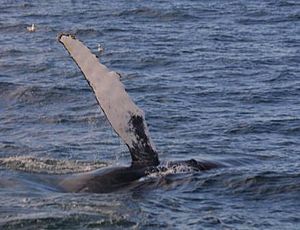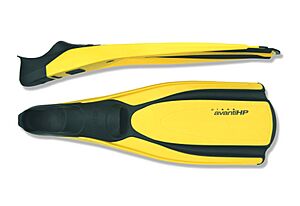Flipper facts for kids


A flipper is a special limb that is flat and shaped like a paddle. It helps animals move easily through water. Many animals that live in the ocean, like whales, seals, sea turtles, and penguins, have flippers. The flipper of a fish is usually called a fin.
Flippers can also be items worn on the foot to help people swim faster and more easily. These are often called swim fins or diving fins.
Contents
What Are Flippers For?
Flippers are amazing body parts that help animals survive in water. Their main job is to help with movement and propulsion. This means they push the animal through the water.
How Animals Use Their Flippers
- Swimming: Most aquatic animals use their flippers to swim. They move them up and down or side to side to create thrust.
- Steering: Flippers also help animals steer and change direction in the water. They act like rudders on a boat.
- Balance: Some animals use their flippers to keep their balance while swimming or even resting in the water.
- On Land: For animals like seals and sea lions, flippers can also help them move on land. They might use them to crawl or "walk" short distances. Penguins use their flippers to waddle and slide on ice.
Types of Flippers in Nature
Different animals have flippers that are adapted for their specific ways of life. Even though they all help with swimming, they can look quite different.
Mammal Flippers
Many marine mammals have flippers. These flippers are actually modified forelimbs, meaning they evolved from what would be arms or legs in land animals.
- Whales and Dolphins: Their flippers are mostly used for steering and stability. Their powerful tails (flukes) provide most of the forward movement.
- Seals and Sea Lions: These animals use their front flippers for propulsion in the water. Their back flippers help with steering. Sea lions can rotate their back flippers forward to help them walk on land.
- Manatees and Dugongs: These gentle giants have paddle-like front flippers for swimming and steering.
Reptile and Bird Flippers
- Sea Turtles: Sea turtles have large, strong front flippers that they flap like wings to "fly" through the water. Their back flippers help with steering.
- Penguins: Penguins are birds that cannot fly in the air, but they are incredible swimmers. Their wings have evolved into stiff, paddle-like flippers that they use to propel themselves through the water at high speeds.
Human-Made Flippers
Humans have created their own versions of flippers to help them in the water. These are usually called swim fins or diving fins.
- Swim Fins: These are worn on a person's feet and make their feet larger and more powerful. This allows swimmers to move through the water much faster and with less effort.
- Diving Fins: Divers use longer and stiffer fins to help them move efficiently underwater, especially when carrying heavy diving gear.
- Monofins: Some competitive swimmers and freedivers use a single, large fin that covers both feet. This design mimics the tail of a dolphin and allows for very fast swimming.
Evolution of Flippers
Scientists believe that flippers evolved from the limbs of land animals that returned to the water. Over millions of years, these limbs gradually changed. Bones became shorter and flatter, and the overall shape became more streamlined. This allowed animals to move more efficiently in their watery homes. This process is a great example of adaptation and evolution in nature.
See also
 In Spanish: Flipper para niños
In Spanish: Flipper para niños

